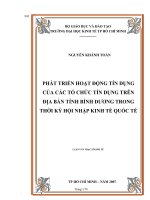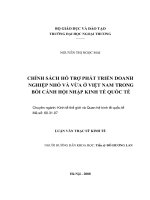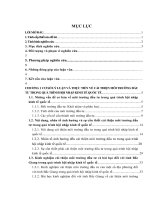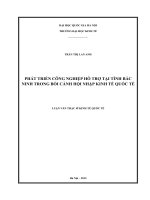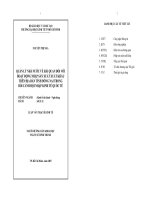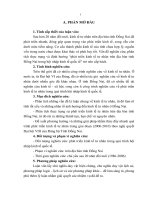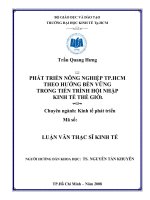Phát triển nông nghiệp trên địa bàn tỉnh hải dương trong bối cảnh hội nhập kinh tế quốc tế tt tiếng anh
Bạn đang xem bản rút gọn của tài liệu. Xem và tải ngay bản đầy đủ của tài liệu tại đây (232.8 KB, 27 trang )
VIETNAM ACADEMY OF SOCIAL SCIENCES
GRADUATE ACADEMY OF SOCIAL SCIENCES
--------------------
NGUYEN HUY CANH
AGRICULTURAL DEVELOPMENT IN HAI DUONG
PROVINCE IN THE CONTEXT OF
INTERNATIONAL ECONOMIC INTEGRATION
Major: Development Economics
Code: 9.31.01.05
ECONOMICS PHD THESIS
HANOI - 2019
The Works is completed at:
GRADUATE ACADEMY OF SOCIAL SCIENCES
SCIENCE INSTRUCTORS:
1. PhD. Le Anh Vu
2. PhD. Chu Van Lam
1. PGS. TS. Chu Đức Dũng
2. S. Trần Thị Nam Trân
Reviewer 1: Prof. PhD. Nguyen Ke Tuan
Reviewer 2: Assoc. Prof. PhD. Ngo Tuan Nghia
Reviewer 3: Assoc. Prof. PhD. Nguyen Van Nam
The Thesis will be defensed in front of the PhD thesis council
held at Graduate Academy of Social Sciences at ….. on …/…/201…
The thesis can be found at:
- The National Library
- Graduate Academy of Social Sciences Library
INTRODUCTION
1. The urgency of the topic
Hai Duong is a province in the Red River Delta region, a tropical
monsoon region with topography divided into two distinct regions (hilly
and mountainous as well as delta areas), this is a condition with full input
elements for many economic sectors, especially agriculture such as good
land, abundant water resources .... Agriculture is a major industry and plays
an important role in the socio-economic development of the Province,
which is a province with favorable conditions and a qualified level of
intensive agricultural production. However, in the context of more and
more deepening international economic integration, the 4th industrial
revolution, climate change..., Hai Duong agricultura is facting big
difficulties, challenges: increasing competition pressure in domestic market;
agricultural growth mainly based on mass use of natural resources, which
causes negative impacts on the environment, causing more polution and
deteriorating the natural resources; there are a loto f obstacles in attraction
of businesses into agriculture, with less investment of big and FDI
enterprises into the agricultural production; the qualification of households,
farm owners remains low, the science and technology in agricultura lack,
and are out of date. The average land cultivation area per capita is low and
on decreasing trend; the agricultural production scale is small, smashed; the
obsolete production, preservation and processing technologies;
productivity, quality and competitiveness of agricultural products are low;
linkage for agricultural development is very faint and loose; supporting
services and infrastructure do not keep up with the development needs of
agriculture; processing industry develops slowly; types of land markets,
labor markets, capital markets and technology markets are not synchronized
and have not operated smoothly. Therefore, there is a need for innovation in
agricultural growth orientation and model, to meet the requirements of
international economic integration, efficiency and sustainable development.
1
Facing the requirement of deeper and deeper integration into the
world and regional economies with many opportunities and challenges, Hai
Duong is stepping up the restructuring of the agricultural sector, focusing
on best exploiting the potentials and advantages, promoting the application
of science and technology to production, reducing losses in production and
post-harvest; land management innovation; reorganizing agricultural
production in association with the development of processing industry and
product consumption; expanding markets for environmentally friendly
products and services; However, the growth rate of agriculture is still low,
lacks competitiveness in the market.
These are the reasons for the researcher to choose the topic
"Agricultural development in Hai Duong province in the context of
international economic integration" as the thesis research topic.
2. Research goals and tasks
2.1. Research goals
- General goal
The research aims to establish theoretical basis, practical basis and
solutions to agricultural development in Hai Duong province in the context of
international economic integration
- Specific goals
+ Clarifying the theoretical basis and practical experience of
agricultural development in the context of international economic integration.
+ Clarifying the status of agricultural development in the context of
international economic integration, factors affecting agricultural development
in the context of international economic integration in Hai Duong.
+ Proposing major solutions to agricultural development in the context
of international economic integration in Hai Duong in the following years.
2.2. Research tasks
To achieve these above goals, the thesis addresses the following
tasks:
2
- To systematize the theoretical basis and practical experience of
agricultural development in association with international economic
integration.
- To analyze and assess the current situation of agricultural
development in Hai Duong province in the past in association with the
context of international economic integration, pointing out successes,
limitations, difficulties and challenges and problems set for the agricultural
sector in Hai Duong province.
- To propose solutions for agricultural development in Hai Duong
province in the context of international economic integration to 2025, vision
to 2030.
3. Research object
The object of the research is agricultural development in Hai Duong
province in the context of international economic integration.
4. Research scope
* Content scope
The research on agricultural development is a very broad and
complex topic, the thesis is limited to research the development of
cultivation and animal husbandry in association with international
economic integration; The issue of selecting the appropriate development
path of Hai Duong agriculture in the new context is a priority issue in the
thesis analysis.
* Spatial scope
The thesis will conduct a research on the status of agricultural
development in Hai Duong province.
* Time scope
The thesis will study the status of agricultural development in Hai
Duong province in the period from 2011 to 2016; propose agricultural
development solutions to 2025, vision to 2030.
3
5. Research methodology
(i) Collecting secondary documents and information:
Type of information: Theoretical basis, practical basis for agricultural
development; Natural, socio-economic characteristics of Hai Duong
province; Agricultural development situation of districts in the province and
study sites.
- Supply sources: The recent related research results are conducted by
research centers, agencies and organizations (reports, proceedings,
scientific research topics, theses, projects). Reports, statistical yearbooks,
plans, resolutions, policies... of localities, documents, economic statistics, a
number of relevant analytical tables, available documents at central and
local agencies; via the internet, radio and magazines... to serve as a basis for
analyzing the contents of agricultural development in the context of
international economic integration in Hai Duong over the past time.
- How to collect: Contacting individuals, agencies, units and
locations to provide information. Checking the authenticity of information
is done by direct observation, selection, arrangement and recording of
information.
(ii) SWOT analysis method:
Analyzing and assessing the situation of cultivation and animal
husbandry on the following aspects: positive points; Limitations;
opportunity; challenges from which agricultural development solutions
are proposed in Hai Duong province in the context of international
economic integration.
(iii) Synthesis, statistics, comparision:
Using the criteria to analyze and assess the current situation of
cultivation and animal husbandry development over research timelines.
Comparison between production organization models, products,
technology, labor, market is done... to make assessments and
conclusions.
4
(iv) Prediction and interpolation method:
Based on the analysis of investigative documents, socio-economic
changes; conditions for agricultural development and factors affecting
agriculture to make predictions about the development of Hai Duong
agriculture in the future. In addition, when conducting research, the thesis
inherits previous research results so far, published sources of information,
materials, as well as summarized reports of related departments and sectors.
(v) Investigation and survey method
- Preparing survey sheets based on the objectives of the thesis
- Surveying typical areas of Hai Duong province such as Binh Giang,
Thanh Ha, Thanh Mien, ...
The thesis carried out the survey by issuing 250 sheets and after
edited and processed by Excel software, calculated by SPSS.20, as many as
121 sheets are obtained in line with the purpose of collecting and
synthesizing opinions from the surveys among enterprises, management
agencies and farmers' households. After that SPSS.20 software is used to
analyze and synthesize tables and research indicators in accordance with the
objectives and contents of the thesis.
6. The thesis contributions
- Building, supplementing and clarifying the system of theoretical
and practical bases on agricultural development based on an overview of
research works.
- Determining the system of criteria groups for evaluating
agricultural development in the context of international economic
integration.
- Evaluating and synthesizing factors affecting agricultural
development in Hai Duong province, pointing out advantages and
difficulties in the process of agricultural development in the context of
international economic integration.
5
- Analyzing the status of agricultural development in Hai Duong
province in the period of 2011 - 2016
- The thesis proposes a number of specific solutions to help
accelerating the agricultural development process in Hai Duong province in
a more effective way in the context of deeper and deeper international
economic integration.
7. The thesis structure
In addition to the Introduction, conclusions, references and
appendices, the content of the thesis is structured into 4 chapters:
Chapter 1: Overview of research projects related to the thesis topic
Chapter 2: Theoretical basis and domestic experience on agricultural
development in the process of international economic integration
Chapter 3: Current situation of agricultural development in Hai
Duong province in the context of international economic integration in the
period of 2011 - 2016
Chapter 4: Perspectives, objectives and some solutions for
agricultural development in Hai Duong province in the context of
international economic integration in the period 2020 - 2025, with a vision
to 2030
6
CHAPTER 1
OVERVIEW OF RESEARCH PROJECTS RELATED TO THE
THESIS TOPIC
1.1. International research works
- Studies on roles, stages and types of economic development and
agricultural development
- Studies on agricultural economic structure, agricultural economics
restructuring and agricultural development experience
1.2. Domestic research works
- Group of works related to agricultural and rural development
- Group of works related to agricultural development associated with
international economic integration
- Group of works related to agricultural development in Hai Duong
1.3. Issues that need to be addressed
In the process of reviewing domestic and international research
works on agricultural development, some issues can be found:
- About international research projects
Studies have examined developing countries' agriculture in the
process of shifting to agricultural commodity production associated with
world agricultural trade; This shows that the economic development of a
country must start from the development and restructuring of agriculture
and be driven by market demand; agricultural transition involves
diversification in the agricultural sector to meet domestic and international
market needs; making arguments about the impact of policy to determine
the development direction of agricultural and rural economy; addressing
issues of regional development policies, policies to support inputs and
outputs for agricultural production, agricultural trade policies; At the same
time, success and failure patterns in agricultural and rural development are
raised and farmers' problems are solved... These studies have reference
value for building a modern agricultura in short-term improve quality and
7
develop products with advantages, enhance brand awareness; and in the
long term, it is moved forward to quality products and high productivity to
ensure national food security and sustainable development.
- About domestic research projects
The studies are focused on Vietnamese territories, with little
correlation and assessment with the region and the world, leading to limited
analysis and conclusions about agriculture. This is a suggestion for the
thesis to approach the current picture of agricultural development and
conditions for developing agriculture in the context of international
economic integration in the following years.
A number of Works that have summarized the theory and practice of
models on cooperation production linkages, and value chains in
agriculture... provide valuable data for the author in the research,
determining how to organize agricultural production to raise the added
value regained in agricultural production in order to raise income for
farmers, solve the relationship of interests in development
Some research works directly in Hai Duong province on the process
of agricultural development have mentioned the following aspects:
economic restructuring of the agricultural sector; rural economic
restructuring in the process of Industrialization and Modernization; land
consolidation; cooperative economy; Recent policies to support farmers to
invest in agricultural mechanization have shown advantages, limitations and
problems for agricultural development in Hai Duong province in the
process of national economic integration. This is a useful reference when
analyzing the theoretical and practical basis for building agricultural
development model in the context of integration in Hai Duong province.
8
CHAPTER 2
THEORETICAL BASIS AND DOMESTIC EXPERIENCE ON
AGRICULTURE DEVELOPMENT IN CONTEXT OF
INTERNATIONAL ECONOMICAL INTEGRATION
2.1. Agriculture and Rural Development
2.1.1. The perspective of agriculture
In the thesis, agriculture is conceived in a narrow meaning, which
means that it is studied according to the production objects of agriculture,
including: cultivation and husbandry. If we understand agriculture in this
way, the potentials and advantages for agricultural production are
associated with nature and socio-economic factors are effectively exploited
to promote sustainable development.
2.1.2 Agricultural development
From the above analysis, it can be seen that agricultural development
is an agricultural movement process from low to height, from handicraft
production to the production of modern machinery and more and more
active participation in the global agricultural product value chain... to meet
the goal of sustainable agricultural development.
2.1.3. Characteristics of agricultural development meeting the
requirements of socio-economic development
+ Large and market-oriented agricultural commodity production
+ Agriculture is built on the basis of advanced and modern material
and technology
+ To attach importance to science, technology and technology in
combination with rational use of traditional experiences
+ Large-scale commodity production, diversification of product
structure, production organization turned into business-styled and business
method turned into careers.
+ High level of specialization, socialization and regionalization of the
production process, creating added value for agricultural products.
9
+ Improving labor productivity, forming value chains in production
and trade, having potential in reducing production costs to create high
competitiveness.
+ Using less labor, attaching importance to labor efficiency, raising
intellectual standards, comprehensively developing rural socio-economic
life
2.1.4. Role of agricultural production
+ For socio-economic aspects:
- Agriculture produces food that meets the daily needs of people.
- Agriculture ensures raw materials for food processing industry
- Agriculture contributes to serving reproducing and expanding needs
of economic sectors
- Agriculture plays an important role in the national economy as its
role in society - raising people is irreplaceable.
+ For environment
- Agriculture and rural areas play a big role, being the basis for the
sustainable development of the environment because agricultural
production is directly linked to the natural environment: land, climate,
weather and hydrology.
- Agriculture uses a lot of chemicals such as chemical fertilizers,
pesticides... contaminating soil and water sources, the cultivation process is
easy to cause erosion in hilly areas and exploitation work expands forest
land... therefore, in the process of developing agricultural production, it is
necessary to find appropriate solutions to maintain and create sustainable
development of the environment.
2.1.5. Theoretical basis on agricultural development
- Theory on agricultural and rural area development
- Theory of sustainable development
- Two-zone model by Harry T.Oshima
- Linkage theory
10
2.2. Internation economic integration on agricultural development
2.2.1. Internation economic integration
International economic integration in the current context is not
merely a limitation in the scope of tariff reductions but has been extended to
all areas related to economic-trade policy, aimed at expanding markets for
goods and services, eliminating tangible and intangible barriers to
international trade exchange.
2.2.2. Content of international economic integration
(i) Preferential trade agreement (PTA)
(ii) Free trade agreement (FTA)
(iii) Customs Union (CU)
(iv) Common market
(v) Economic-monetary union
2.2.3. Content of agricultural development in the context of
international economic integration
2.2.3.1 The need for agricultural development in the context of
integration
It can be said that agricultural development in the context of
integration will achieve the following benefits:
+ Allocating resources in agriculture
+ Diversifying products and markets
+ Receiving new science and technology, improving quality,
productivity
+ Improving the quality of human resources in agriculture
2.2.3.2 Content of agricultural development in the context of
integration
- Sustainability-oriented agriculture development
- Export-oriented agricultural development
- Application of high technology in agriculture
11
2.2.4. Criteria for assessing agricultural development in international
economic integration
- Criteria group of general agriculture development
- Criteria group of economic efficiency
2.3. Factors affecting agricultural development in the context of
international economic integration
2.3.1. Climate Change
2.3.2. Infrastructure structure
2.3.3. Capacity of production subject
2.3.4. Science and technology
2.3.5. Mechanisms and policies on agricultural economic
development
2.4. Experience of some localities on agricultural development in
the context of international economic integration
2.4.1. Experience in developing high-tech agriculture in Da Lat, Lam
Dong province.
2.4.2. Experience in husbandry in Dong Nai
2.4.3. Experience of An Giang province
2.5. Lessons learned applicable to Hai Duong province
Agriculture is of special importance, having a key position in the
economic structure of the country in general and of Hai Duong province in
particular. Through studying agricultural development experiences of some
provinces in the country, Hai Duong will have many lessons in the strategy
of sustainable agricultural development.
2.5.1. Lesson of success
Firstly, properly identifying the relationship between industry and
agriculture in the process of industrialization and modernization and socioeconomic development of Hai Duong.
Secondly, agricultural development is associated with the protection
of environment and natural resources.
12
Thirdly, agricultural and rural development is associated with
poverty reduction and improvement of rural living standards.
Fourth, in order to have a clean agriculture, sustainable development,
high productivity, with valuable products, it is needed to have a "fourhouse" structure in processing and consumption. At the same time, it is
required to promote the development of high-tech agriculture in association
with market demand, considering high-tech agriculture as a breakthrough to
develop high-quality, efficient and sustainable agriculture.
2.5.2. Lesson of failure
Firstly, agricultural economics restructuring is still limited
Secondly, most provinces still develop agriculture without
environmental sustainability
2.5.3. The cause of this limitation is due to:
Firstly, thinking and vision reflected in the planning and organization
of agricultural development in the new conditions of many local levels in
our country are not yet complying with market rules.
Secondly, small, scattered, fragmented production organizations
which have not linked sustainable benefits among entities involved in
production and consumption; no value chain has been established and the
ability to participate in agricultural value chains remains poor; waste of
natural resources; seriously abusing chemical substances, including toxic
substances in the production, processing and preservation of agricultural
products for short-term and immediate benefits; not paying adequate
attention to the health of both producers and consumers; management of
quality standards for agricultural products is particularly poor.
Thirdly, the agricultural production method is heavy in seasonality,
agricultural technology level and infrastructure system are out of date; it is
not yet active in breeding structure and breeding technology, genetic
technology; The market for agricultural products is very unstable, strongly
dependent on a few markets; The market of inputs with many negatives
13
causes very high risks for both production and consumption; The overall
strategy and policy of godos items, godos sectos, and value chains are not
associated with backed financial resources, or there are financial resources
but wastefully used so no practical effects have been brought.
Fourth, the ability to access land, credit, and energy for production of
both farmers and enterprises that want to apply high technology has many
barriers in terms of policies and psychology from farmers.
Fifthly, the impact of climate change is fast with strong intensity,
having deeper impact than the adaptability of the whole agricultural sector;
The strategic competition of many strong agricultural countries is putting
pressure on home failure for the country’s agriculture, the impact of climate
change and sea level rise, causing saline intrusion, extreme weather events
occuring with strong intensity, or deeper, faster impact due to the
adaptability of people and businesses.
14
CHAPTER 3
CURRENT STATUS OF AGRICULTURAL DEVELOPMENT IN
HAI DUONG PROVINCE IN THE CONTEXT OF
INTERNATIONAL ECONOMIC INTEGRATION IN 2011-2016
PERIOD
3.1 Conditions affecting agricultural development in Hai Duong
province in the period of 2011 - 2016
3.1.1. Natural condition.
* Topography and geomorphology
* Land resources and current status of agricultural land use
3.1.2. Social and economic conditions
* Population, labor, employment and income
* Technical infrastructure
3.1.3. Assessing the impact of natural - economic - social conditions
on agricultural development in Hai Duong province in the period of 2011 2016
* Advantages and potentials
* Difficulties and limitations
3.2. Current situation of agricultural development in Hai Duong
province in the context of international economic integration, period
2011 - 2016
3.2.1. Mechanism and policies of Hai Duong province for
agricultural development
3.2.2. Sustainability-oriented agricultural development
3.2.2.1. Economically
3.2.2.2. Socially
3.2.2.3. Environmentally
3.2.3. Export-oriented agricultural development
3.2.3.1. Consumption market of crop products
3.2.3.2. Consumption market of livestock products
15
3.2.4. Application of modern technology in agriculture
3.2.4.1. For cultivation
3.2.4.2. For husbandry
3.3. Survey results on agricultural development in Hai Duong
province
Based on the survey with the objects of state management agencies,
farmers and enterprises with 250 sheets issued and 121 valid votes collected
in Hai Duong province
3.4. Evaluating some successes and limitations for agricultural
development in Hai Duong province in the period of 2011 - 2016
3.4.1. Successes
* Agricultural production has achieved a high and steady growth rate
over the years
* Awareness of commodity production and markets among farmers
has been raised by one step
* Production has been step by step developed towards industry
3.4.2. Limitations, weaknesses and causes
* Limitations and weaknesses
* Some causes leading to limitations and weaknesses
16
CHAPTER 4
PERSPECTIVE, OBJECTIVE AND SOME SOLUTIONS FOR
AGRICULTURAL DEVELOPMENT IN HAI DUONG PROVINCE
IN THE CONTEXT OF INTERNATIONAL ECONOMIC
INTEGRATION IN 2020-2025 PERIOD, WITH A VISION TO 2030
4.1. International and domestic contexts for agriculture in Hai
Duong province period 2020 - 2025, with a vision to 2030
4.1.1. International context
4.1.2. Domestic context
4.2. Impact of international economic integration on agriculture
in Hai Duong province in the period of 2020 - 2025, with a vision to
2030.
4.2.1. Advantageous factor
- Expanding export markets for agricultural products
- International competition is a driving force for Vietnam's
agricultural development:
- Integration creates opportunities to attract foreign investment:
- Promote scientific and technological applications:
4.2.2. Challenges in the trend of international economic integration
- Facing many barriers in agricultural product exports:
- Countries in the region invest in agricultural development,
increasing competitiveness.
4.3. Analysis of SWOT matrix for agricultural development
model in Hai Duong province in the context of international economic
integration
From the SWOT matrix, it is possible to have general orientations for
the modern agricultura model for Hai Duong province in the coming time,
specifically:
(1) Planning large-scale production areas (large fields), developing
key and advantageous crops and livestock.
(2) Investment in new construction, expansion of processing and
storage areas of agricultural products after harvest near material areas.
(3) Continuing to expand the market and diversify products.
17
(4) Promoting research and transfer of new technologies, new
biotechnology, selecting new varieties with high productivity and good
quality to put into production.
(5) Strengthening agricultural and fishery encouragement work and
market promotion information for agricultural production entities.
(6) Promoting linkage, cooperation, forming value chains in
producing and consuming agricultural products, creating added value for
agricultural products, thereby improving investment efficiency.
(7) Increasing to open professional training classes, technical and
management training for agricultural production entities; promoting the role
of associations and unions in propaganda and education to bring scientific
and technological advances to production.
(8) Continuing to replicate and transfer effective production and postharvest models and formulate high-tech agricultural zones.
4.4. Perspective, objectives for agricultural development in Hai
Duong province in the context of international economic integration in
2020-2025 period, with a vision to 2030
4.4.1. Development perspective
+ Attaching agricultural economic development with effective
implementation of social policies and environmental protection. Ensuring
social equality in rural areas, reducing the disparity in life between regions,
localities in the province, protecting the land and protecting the ecological
environment.
+ Taking a short walk, synchronously applying scientific and
technical advances in varieties, techniques of crop cultivation, techniques of
raising cattle and poultry, developing mechanization, selecting and applying
High-tech intensive farming techniques in accordance with actual
production conditions and economic potential, farmers' level to continue to
improve productivity, quality and competitiveness of agricultural products.
+ Increasing investment in infrastructure for agriculture
+ Enhancing investment attraction in the sector when new
opportunities come from integration, agriculture will welcome new
investment flows, especially investment in high-tech agriculture and
18
supporting industries for the Agriculture sector – which are currently left
open due to lack of resources. The spillover effects from increasing
investment in agriculture will be really important to the economy
4.4.2. Development Goals
Cultivation:
+ The main goal of the cultivation industry is to meet the demand for
food consumption, contributing to ensuring the national food security.
Reducing the area of growing food crops to the necessary level, maintaining
and expanding the concentrated production areas of traditional vegetables,
having a stable consumption market (beans, carrots, onion,...) and
increasing efficiency on each one cultivated land ha by planting high
economic value trees
+ By 2020, striving to increase the average production value of
cultivation by 0.8%/year. Development of commodity production is
concentrated in the form of "large fields", "associated fields" together with
preserving, processing and consuming products following the value chain.
Applying scientific and technological advances, bringing new varieties and
mechanization into production to increase productivity and reduce labor.
Encouraging expansion of production models in accordance with good
agricultural practices (VietGap, AseanGap, GlobalGap) and organic
agriculture to improve product quality, encouraging businesses to invest in
existing processing facilities, cold storage system to preserve and process
agricultural products, improve the output value and product value.
+ In the period of 2025 - 2030, cultivation is still a sector with a high
proportion, contributing to stabilizing the lives of the majority of farmers,
however, the quality of development and plant structure must be changed to
suit the more and more increasing consumption demand.
+ Agricultural land tends to decrease due to shifting to industry,
construction, services, urbanization and other uses, so intensive farming
increases productivity, reasonable arrangement of crops, maximizing land
use factor are among the basic measures in the development of the
cultivation, continuing to implement the policy of land accumulation,
19
forming concentrated production areas, creating goods of great value on a
single area.
Husbandry
+ Planning concentrated livestock and poultry rearing areas with
appropriate scales in order to bring into play the strengths of each locality,
ensuring convenience for production, processing and consumption and
environmental sanitation.
+ Production of goods associated with the market.
+ Large-scale concentrated animal husbandry production in
association with the construction of disease-free areas and treatment of
environmental pollution in animal husbandry for safe food with high
productivity and quality, meeting the more and more increasing demand of
people in the province and participating in export markets.
4.5. Some solutions for agricultural development in Hai Duong
province in the period of 2020 - 2025, with a vision to 2030
4.5.1. Group of solutions for sustainable agricultural development
4.5.1.1. Economic field
+ Developing mechanisms and planning for agricultural development
+ Improving the quality of human resources
4.5.1.2. Social field
4.5.1.3. Environmental field
- Strengthening propaganda, raising awareness of officials, party
members and people on the sense of rural environmental protection, guiding
people to implement laws and measures to protect the environment
- Completing regulations on environmental protection
- Directing and strictly dealing with pressing places in the
environment
- Strengthening the environmental monitoring network, inspecting
and strictly handling violations according to the provisions of law
4.5.2. Group of solutions for agricultural development towards export
+ Development of agricultural markets towards integration
- Clearly defining the markets in order to have a strategy and plan for
product consumption development suitable to each type of market
20
- Strengthening the organization of consumption networks in the
province on the basis of developing the network of purchasing, distributing
and retailing agricultural products through the construction and expansion
of wholesale markets, shops and supermarkets in suitable places, bringing
products to reach consumers conveniently
- Participating in trade promotion programs in targeted markets,
attending domestic and foreign trade fairs for agricultural products with the
participation of the community, especially the top enterprises province.
- Promoting the construction of trademarks for agricultural products
that have the advantage of developing strong, highly competitive brands in
the market.
- Developing multi-lingual websites and documents on provincial
agricultural products.
+ Step by step participating in the global agricultural value chain
For production organization issues
- Innovating and building economic models, effective production
organization forms
- Continueing to renovate mechanisms and policies for the
agricultural sector
- Construction of agricultural product processing facilities
For agricultural product business issues
- Increasing investment in trade promotion activities, providing
market information
- Investment in building forces for forecasting research and market
information
- Investment in construction and operation support for trading floors
- Quickly developing distribution system, logistic system, support
ingservices for agricultural products
For activities to create close links between businesses and farmers;
building and promoting brands for Vietnamese agricultural products
4.5.3. Group of solutions on high-tech applications
- Promoting the application of biotechnology science and technology
achievements into production
21
- Investing in modern machinery and equipment, advanced
technology, replacing obsolete technologies and equipment to increase the
rate of deep processing with high added value for export and domestic
consumption.
- Researching and manufacturing small and medium-sized equipment
lines suitable to the scale of material areas, ensuring modern technologies
and advanced equipment.
- Encouraging enterprises to implement product quality management
following international standards
- Enhancing research or linking with research institutes and
universities to receive technology transfer
- Supporting to build demonstration models of processing agricultural
products, techniques for processing frozen meat, dried agricultural products,
canned agricultural products, ... for enterprises in the province
- Regularly paying attention to honor the examples in production and
business in the agricultural sector, prestigious brands, artisans.
4.5.4. Group of solutions for implementation
+ Department of Agriculture and Rural Development
+ Department of Industry and Trade
+ Department of Planning and Investment
+ Department of Natural Resources and Environment
+ Department of Science and Technology
+ Department of Finance
+ Coordination Office for new rural program of the province
+ Provincial Fatherland Front Committee, socio-political
organizations
+ People's Committees of districts, cities and towns
22
CONCLUSION
1. Agriculture is one of the most important and complex economic
sectors, playing a major role in economic development in most countries,
especially in developing countries like our country. Agriculture ensures
adequate supply of human life with the essential products that are food.
These products, despite the current development of science and technology,
have not been replaced by any industry.
2. Hai Duong is a key agricultural province of the Red River Delta,
which there are many advantages in geographical location, natural and
socio-economic conditions for comprehensive agricultural development to
meet development needs of the local economy and for export.
3. In the process of industrialization and modernization, agriculture
still accounts for a high proportion in the GDP structure. By 2017, the
agriculture, forestry and fishery sector attracts nearly 70% of the total labor
force of the province and contributes nearly 30% of the GDP structure. It
metes the needs of food for people in the province and neighboring
provinces.
4. Hai Duong's Agriculture - Forestry - Fishery Structure is
witnessing positive shifting in line with the country’s overall economic
restructuring to the direction of reducing the proportion of agriculture and
increasing the proportion of forestry and fisheries in order to meet
integration requirements
5. The goal for Hai Duong agriculture is to develop high quality
agriculture; scale up and improve productivity and quality of products on
farms; plan specialized cultivation areas suitable to the processing industry;
promote specialization in agricultural sub-regions, continue to promote the
restructuring of plants and animals. Ensuring food security for the province
and national reserves.
6. In order to realice the above objectives, the province needs to
synchronously implement solutions on management organization, land
policy, increasing investment in infrastructure, technical and material
facilities, promoting advanced science and technology applications,
agricultural extension policies, system of mechanisms and policies, rational
23
